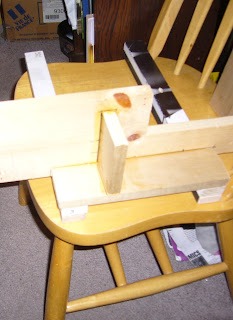As my lumber seasons, and as I progressively refine my plans for how to fit the final instrument together, all the while feeling thankful that I have not charged ahead with the construction yet, one of the sub-projects which has come to the fore is to build a saw-guide. This is to allow me to make crosscuts through wide planks of lumber, at arbitrary angles. Initially, I need it to cut the lumber for the case of the pandalon. The inner frame of the instrument is made of 2x4s, but then there is an outer shell of 1x6s, adding a little more stiffness and defining the final top-to-bottom width of the case: still pretty low-profile. The case lumber, like the 2x4s, needs to be cut with assorted mitred angles, so that it all glues together as symmetrical end-grain joints. The power chop-saw I used to cut the angles on the 2x4s, is not able to handle wider lumber; and plus, I want to cut these by-hand, although I'd consider a circular power-saw with smaller teeth and maybe turning slower, if I had such a thing.
Considering future plans as well, as long as I'm building such a guide, I wanted it to be able to handle at least 8" wide lumber. So-called mitre saws, though they have good teeth for fine cutting, usually have reinforced back edges to their blades, so that the maximum cut depth has to be less than the width of the blade, i.e., 2 or 3 inches at best.
All the hand saws at Home Depot have these wicked-looking long shark teeth nowadays. They look like they'd be great for ripping through rough-hewn timbers and tree branches really fast, but I don't trust them to make a fine cut: I just don't see how it could even work. Maybe I should give them a chance. But instead, I picked up a nice hand saw intended for cutting PVC pipe: it has nice small teeth, and a narrow cut-width (whatever that's called). I could never cut even a vaguely straight line at a desired plane by-eye with a saw like this, I've embarrassed myself every time I've tried. But I hoped that with the guide, I could get better results -- and as you can see, I certainly did.
The 1x3s comprising the guide itself are held apart by the thickness of #6 metal washers. Everything is held together with sheetrock screws to clamp it down, but then all joints are glued with Titebond II. (My first time experimenting with this glue, vis a vis the "new formula" Elmer's wood glue; I'm planning to use Titebond II extensively to put the pandalon together, and using it here did not show up any difficulties with that plan.)
Now that's the kind of result I'm talking about! It may seem trivial to those experienced in woodwork, but to me, these precise cuts are so much better than almost any other cuts I've made in wood, in all my years of puttering around with it, that I'm very excited. I knew results like this were necessary to build what I'm planning to build, but to see it for the first time concretely, greatly improves my confidence in my overall instrument-building ambitions. The right tool really helps.




No comments:
Post a Comment